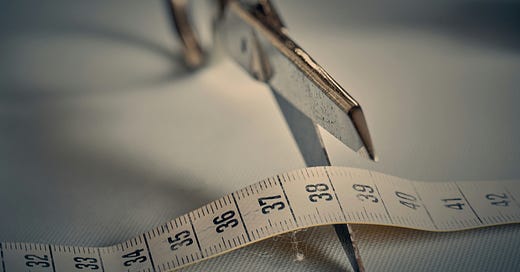
Newsletter writers agonise over length like it's the secret to reader loyalty.
We obsess over it as if the perfect word count will save us.
But what does that even mean?
I've been writing my own newsletters for over a year. I also write for a wide variety of clients. I haven't found a single perfect answer. But what I have found is much more useful.
Length isn’t the problem; reader experience is.
Ask Better Questions
You're stuck on a desert island with no power.
Which writing tool do you choose?
A typewriter?
Or an abacus?
Exactly.
Asking "How many words?" is not going to get us anywhere.
Instead, it's helpful to consider what each individual article means.
What’s the goal of this issue? (educate, entertain, persuade, update?)
What do readers expect from you?
What kind of content suits your voice?
How much attention are your readers likely to give you?
Nailing our answers to these points helps with each issue and contributes to finding our own writing style for the future.
Format Matters More Than Word Count
Often our title guides us towards our outline.
Then, our outline shows us the overall format of the article.
Short newsletter? Great—if it’s useful.
Long newsletter? Still great—if it’s skimmable.
Use headings, bolding, bullets, or visuals to break up long content.
Examples of different newsletter "types" with length expectations:
Daily thought (like Seth Godin): 100–200 words
Curated links: 3–5 links with blurbs (250–500 words)
Deep dives or essays: 800–1500 words
Hybrid format: A short note + links + promo
As long as the end result is clear, it's fulfilled its purpose.
Length Isn’t Why People Unsubscribe
Just like you on that desert island, your reader is not sitting there with a calculator, ready to pounce for the click-away when your count breaches a random number.
People leave when:
It’s boring.
It’s irrelevant.
It’s poorly written or overwhelming.
But not because it’s 200 words too long.
A Simple Guide To Finding Your Format
Many of our writing discussions end up with us using a "test and tweak" approach.
There's a reason for that.
Unlike "the old days" (you know, before), writing online allows us to try, try, try again until we find what works.
So, let's take it easy and take our time:
Pick a structure and stick to it for 3–5 issues.
Watch your open rate, replies, and click rate.
Ask your audience directly—what do they like or skip?
Be prepared to evolve over time.
TL;DR—Length Is a Side Issue
It's all about the rhythm.
Your newsletter should feel like a good conversation—not a blog post that missed the cut.
Write with purpose. Format with care. Stop counting words—count moments of impact.
Here at WWOTI, most issues come in at less than 1000 words.
With a moderately technical topic of writing tips and an aspirational reading level of Grade 4 or so, each issue takes most readers less than five minutes.
I only know this because I went back to check.
As I write and edit, I'm feeling my way through the reader experience.
I'm not counting either the words or the minutes.
I'm counting the frequency of "Aha!"
Recent discussions in the Substack community indicated a broad spectrum of opinion.
Everything from:
"More than five minutes and I'm out."
To:
"I love a good, long read!"
The reality?
A good newsletter feels shorter than it is.
What kind of newsletters do you actually read to the end?
Hit the Comments and tell me—I read everything.
And if you'd like a little help shaping a newsletter your readers actually finish, let’s chat.
Thanks for reading.
Don't forget to check out my other newsletter, The Dancing Stepdad, for insights into the challenging and rewarding world of step-parenting.
And if you found today's issue helpful, I'll bet you know someone else who'd like it too. Share the love and tell your friends!




Someday I may write a newsletter, though I’m not currently and don’t have plans to start. Why then, do I read yours?
It’s a good question. If I had to explain, I’d say it’s because I like to learn new things, and you inform. The style of your writing is low key conversational in feeling while structured in design. I appreciate that you don’t appear to be trying to sell me something. (I’m the person who flees when a sales person shows up at the shoe store to “help” me.)
Thank you.